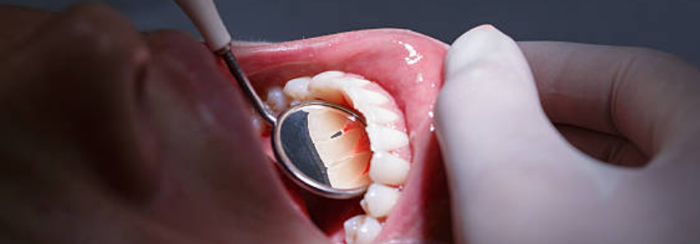What Can Be Done About My Receding Gums?
If your smile is looking “long in the tooth”, these treatments can restore and protect your gums from further damage.

Gum recession is a quite common oral health condition where the gum tissues around the teeth begin to pull back or recede, which can expose the roots.
If a patient notices their gums beginning to recede, they should take the right steps to prevent any further gum loss, or arrange a procedure to treat their condition if required - because when severe recession is left untreated, the consequences can be devastating.
The following are common factors known to contribute to gum recession:
- Poor oral hygiene and gum disease (not brushing twice a day and flossing once a day is a surefire way to promote infection of the gingiva and teeth)
- Vigorous or aggressive teeth brushing, particularly using a toothbrush with hard bristles)
- Heredity (research reveals that as many as 30% of people may be predisposed to gingival disease, which can lead to the recession of gum tissue)
- Age (gum recession is a condition more likely to affect adults)
- Tobacco use/smoking
- Grinding or clenching the teeth
- Malocclusion or crooked teeth
- Hormonal changes (Females who are pregnant, for example, may be more prone to gum disease)
Early warning signs of gum recession
If you notice some teeth that appear longer than the others, or you can tell that there is more tooth exposed than usual, let your dentist know. This is a common sign of gum disease, and a strong indication that your gums have begun to recede. You may also experience heightened sensitivity on these teeth, as receded gums will expose more of the tooth including the tooth’s root, which contains sensitive nerve endings.
It’s important to address this problem early (or as soon as you notice it), so that you can prevent any further progression of gum deterioration.
With severe gum recession, gaps or “pockets” form between the teeth, leading to a progressive buildup disease-causing bacteria. If a patient does nothing to stop its progression, the teeth will gradually become looser, and they may ultimately fall out.
How to prevent receding gums in the first place
In order to properly preserve the health of your gums, it’s important to adhere to a thorough daily oral care routine that includes gentle twice-a-day tooth brushing, for two full minutes each session. Since harsh or aggressive brushing is a known and leading contributor to gum recession over time, it’s paramount that you make it a priority to brush your teeth gently (preferably using a soft bristle brush, or electric toothbrush) and avoid ever using any force on the gums and teeth.
Additionally, it’s critical that you floss once a day in conjunction with brushing, or you’ll be leaving bacteria to fester between the teeth and below the gum line - leading to the rapid development of infection and, over time, destroyed gum tissue.
Along with a proper daily oral hygiene routine, schedule routine cleanings with our hygienist (recommended every 6-9 months), which will prevent the accumulation of stubborn disease-causing bacteria and plaque through professional removal that can’t be achieved through at-home brushing and flossing alone.
If you use tobacco products or smoke, strive to put an end to the habit. If you think you may be grinding your teeth while you sleep, let your dentist know. A mouth guard will be able to prevent any further damage.
Treating receding gums
When treating gum recession, the type of treatment is highly dependent on the level of gum recession a patient is dealing with.
Typically, milder cases of gum recession can be further prevented with a professional deep cleaning performed by a hygienist or periodontist - a procedure referred to as scaling and root planning:
Scaling and root planing: With scaling, the dental professional will employ a special handheld tool to scrape away and eliminate the hardened deposits of plaque and tartar on the teeth’s surfaces and below the gum line. With root planing, the professional will scale and smooth out the root surfaces of the teeth, which is a critical step in order to resolve any gum tissue inflammation that results from periodontal disease.
For more significant cases of gum recession, gum surgery is often needed. Treatment options of this kind include a gum graft procedure or pocket depth reduction:
Gum graft surgery: A common and successful treatment for receded gums, a gum grafting procedure restores receded and lost periodontal tissue through harvesting these tissues from other areas, such as from the roof of your mouth. Gum grafting surgery plays a fundamental role to prevent further damage of the gum and bone, while also helping to protect the exposed roots of the teeth from decay and decrease root sensitivity.
Pocket depth reduction (flap surgery): With more severe and advanced stages of gum disease (periodontitis), the gum tissue may be dramatically receded and detached from the teeth, creating gaps or pocketing between the teeth and gums.
A pocket reduction procedure, otherwise known as flap surgery, involves the folding back of gum tissue in order to eliminate any infectious bacteria while also smoothening any areas of affected bone. Ultimately, the goal of pocket reduction surgery is to encourage the reattachment of the gums to healthy bone, thus reducing the severity of pocketing between them.
Suffering from gum recession?
If you suspect that your gums have been receding, it’s time to book an appointment with your dentist.
As with every oral health issue, prevention and early intervention are key. Take the first step to healthy gum recovery and book your visit with an Ontario Teeth First Dental Network clinic near you today!